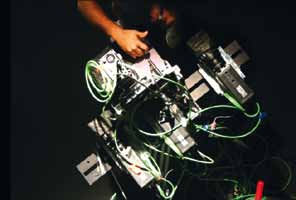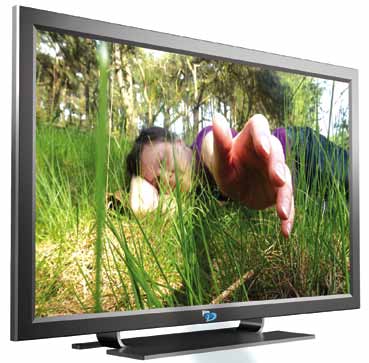The technology is being tried in-house by the team, in small screens. It might take a few years for it to be fine-tuned sufficiently for commercial use. Going forward, the team hopes to refine the method and apply it to developing other single-projector, frontal methods of 3D display, using technologies such as passive polarisation-activated lens arrays and the lenticular lens approach.
4. 3D Analyser: Making 3D content creation easier
3D television is catching on here and there in the world, but not as fast as manufacturers would like. One reason is the lack of good-quality content. This shortage is often attributed to the cost and time involved in creating 3D content—especially the post-production processes. A new technology has been devised that makes it possible to generate 3D content in real time—that too for viewing without glasses.

Polarisers are attached in strips to the screen, which gives a Venetian blinds’ ‘slat’ effect to create 3D (Image courtesy: www.dailymail.co.uk)

Multi-camera content creation (Image courtesy: hhi.fraunhofer.de)
The cost, weight, power consumption and bandwidth requirements of auto-stereoscopic videos are too much. To create high-quality auto-stereoscop-ic content, numerous camera angles of each shot are needed. However, it is costly and impracticable to place 10-20 cameras on a set. This led to the 3D Analyser project at the Fraunhofer Heinrich Hertz Institute.
In the past, the team had developed a stereoscopic analyser called STAN that corrects standard 3D images in real time to make live broadcasts possible. The new tool builds upon STAN to generate up to 25 views of the same scene from slightly different viewpoints—thereby making glasses-free 3D possible. The tool works well when tested offline in the lab, but a lot of work needs to go into making it suitable for real-time broadcasting.
5. MIT’s Tensor Display – More life to 3D
The actual 3D view that we get of life around us is very different from what we see on 3D screens today. When we move, our perspective of an object changes in real time. However, when we move in front of a 3D screen, we see only a distortion! To create a realistic image without distortions would require hundreds of perspectives and screens with fantastic refresh rates—a challenge that continues to daunt the 3D industry.
That said, the Massachusetts Institute of Technology, Boston, has recently developed a wide field-of-view LCD technology that can, they claim, display 3D in a more life-like way than other standard 3D displays, without the need for glasses. Called a Tensor Display, it comprises stacks of light-attenuating layers, such as multi-layer LCDs. Rapid temporal modulation of the layers is exploited, in concert with directional back-lighting, to allow large separations between viewers. Tensor displays support smooth motion parallax and binocular disparity at a high resolution for a large depth of field over a wide range of viewpoints.
To help you understand the technology better, let me draw a parallel with the double-screened Nintendo 3DS, which is also made up of multiple LCD layers. However, the Tensor Display consists of three screens, rather than the two used in the gaming device, since MIT’s technology is meant for larger screens. To make a TV or a larger display that presents highly realistic 3D images would require hundreds of perspectives and a refresh rate of over 1000 Hz, if only two screens are used. Using a third display pulls down the refresh rate requirement to 360 Hz because it displays yet another pattern, which has a whole new set of algorithms to help cut the amount of information sent to LCD screens.

MIT’s Tensor Display uses multi-layer LCDs and directional backlighting to present realistic 3D views without glasses
6. Ultra-D: Setting new standards for 3D quality
An Indian-led company called Stream TV Networks in Philadephia is creating waves in countries like Germany, China, UK and France, with its new glasses-free 3D technology called Ultra-D. Mathu Rajan, CEO of Stream TV Networks, summed it up neatly in a recent press report: “Ultra-D is the first 3D-without-glasses solution that has been able to eliminate viewing angles and offer the high-quality, glasses-free 3D experience we all have been waiting for. We have received positive feedback that Ultra-D is the only 3D-without-glasses solution developed that is ready for the consumer market.”
Ultra-D has been demoed at various expos and seems to have received a warm welcome by the market. Recently, Stream TV Networks announced a technology partnership with Hisense to create a line of televisions and other products featuring its Ultra-D technology. To begin with, they will be launching a 107cm (42-inch) 1080p auto-stereoscopic 3D display.
You would have realised by now that most of the parallax barrier based displays require the user to sit still in a sweet spot to get the desired effect. While this is okay for smart phones and even gaming devices to some extent, it is a huge drawback in devices like TVs. Ultra-D uses a different technology to overcome this problem. It uses a microlens that covers the standard display and, with the aid of their proprietary software and firmware, shows viewers up to nine images—each with a slightly different angle on the scene. This way each eye will see four images, for example, and as you move around to different viewing angles, you see a slightly different image that retains the 3D effect. The best part is that the technology package includes an auto-converter box called SeeCube that can seamlessly convert 2D and 3D stereoscopic media into a glasses-free 3D format in real time.

Ultra-D screen
Ultra-D technology can be used with PCs, digital photo frames, tablets, TVs, set-top boxes and so on—not to forget its applications in non-commercial spaces like military, medicine, research and therapy. It also supports numerous video feed formats including cable and satellite TV channels, Blu-ray, XBOX, PS3, and media websites such as Netflix, Hulu and YouTube. It can also convert content from iPad, iTunes, Appstore and Apple TV. So users can plug any source into the box and watch glasses-free 3D content on their Ultra-D displays. Reviewers say that Ultra-D’s resolution is not as high as other 3D TVs’, but this problem can be overcome with a bit of fine-tuning.
In short, there is a lot of activity on the auto-stereoscopic 3D front. Companies like Tridelity AG have glasses-free displays that can be used for signage, etc. Industry leaders like LG, Samsung, Sony and Philips have prototypes and niche models. Sony, for instance, is known to have filed a patent application related to this in May this year. The patent pertains to an auto-stereoscopic display that adjusts the separation of the two images (for both eyes) automatically according to a viewer’s distance from the screen, to ensure optimal viewing from many several positions and viewing angles. While no such product has been announced by the company yet, this goes to show that almost all industry majors have their eyes on glassless-3D. While it might take months or even years, surely viewers will prefer to watch 3D without glasses once the wrinkles in the technology are ironed out.






